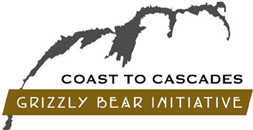Bear Safety
Good bear safety and awareness helps prevent conflicts and keeps both bears and human safe.
Coast to Cascades is working to restore grizzly bear populations in Southwest British Columbia. Humans remain the biggest cause of grizzly bear deaths in BC whether due to direct conflict or indirectly through habitat loss. If we are going to be successful in reviving grizzly populations, we as humans need learn to live with them safely and respectfully.
Know Your Bears
In Southwest BC a lot of us are used to living around black bears. However, we may not be as familiar with seeing grizzly bears out on the land. As grizzly populations slowly begin to grow in some regions, such as around Whistler and Squamish, it's important to be able to identify the two species.
Black Bear
No shoulder hump
Front claws are short and dark
Have tall, prominent ears
Have a long, straight snout
Pawprint leaves a curved line made by the front toes
Colour varies from black to brown
Grizzly Bear
Have a prominent shoulder hump
Front claws are long and light
Have small, rounded ears
Have dished snout and face
Paw print leaves a striaght line made by the front toes
Colour varies from black to brown
Bear Safe Communities
Keeping bears from human spaces is an important part of keeping both bears and humans safe. As urban areas encroach on bear territory, we need to reduce the incentives for hungry bears to seek out human populated areas. We can do this by:
Reducing bear attractants: Store garbage in bear-proof containers, do not leave unattended food outside, harvest fruit before it ripens. Here’s how you can make your own quick and effective ‘DIY Fruit Picker’
Give bears space: If a bear passes through don't crowd it. Keep children and pets inside.
Make bears unwelcome: As long as the bear has a clear avenue of escape, try to scare it away with loud noises. After it's gone remove any non-natural foods that might have attracted it.
Call a conservation officer: Call 1-877-952-7277 to report (1) a bear sighting in a human area, (2) a bear conflict, (3) wildlife attractants like open garbage. Conservation officers have many non-lethal ways of managing bear conflict. Conditioning a bear to avoid human areas early on reduces the risk of a fatal conflict down the road and could save the bear's life!
Bear Safety for Recreationists
When hiking, biking and exploring in the backcountry, it is important to remember that we are in the bears' home and that we act respectfully. Seeing bears out on the land can be an amazing experience, from a safe distance of course! Educate yourself before you enter Bear Country for everyone’s safety. There are books, videos, and resources available to help you feel safe and knowledgeable about bear encounters and experiences.
Learn about the threatened grizzly bears of the Sea-to-Sky corridor, how our recreation activities impact them, and how we can do better. A partnership of AWARE and The Coast to Cascades Grizzly Bear Initiative (C2C).
Team up: Travelling in groups is a backcountry rule in Bear Country.
Be alert: Be on the look out for bear signs such as scat, tree marks or tracks. Also pay attention if you are around a potential bear food source such as a berry patch or salmon run. It’s best to avoid or make a wide detour from these areas.
Let bears know you're there: Alert bears in the area to your presence by making a lot of noise especially when sight is limited and there is other noise like wind or water. Sorry, ‘bear bells’ are not loud enough. Calling out, talking, or clapping is effective.
Bear encounters: Stop, speak in a calm voice and back away slowly. Never go near a bear cub, as it may provoke the mother bear to attack.
A bear which is growling, "popping" it's jaw or has its ears laid back is warning you that you're too close. Bears will often bluff charge, stopping short of actual contact. As hard as it sounds don't panic; running, waving your arms or attacking the bear will only provoke it.
Bearsmart.com has more information on the different types of encounters, and what to do.
ALWAYS bring bear spray: Bear spray is an extremely effective, non-lethal bear deterrent. Learning how to use it and always having it accessible is a great way to keep you and bears safe.
Bear Safety for Hunters
As a hunter a lot of your actions such as moving stealthily, approaching game from downwind and handling big game carcasses put you at greater risk of a bear attack than the average hiker. It is even more important to alert and cautious at all times.
Bear spray: Carry bear spray at all times IN ADDITION TO YOUR FIREARM. Bear spray is shown to be a much more effective defensive option against a bear than a fire arm. It is easier to deploy a cloud of spray than a defensive shot at a charging bear.
Southern BC grizzlies are endangered: Due to their low numbers it is illegal to hunt grizzly bears in southern BC. Hunters are expected to do everything possible to reduce bear conflicts and prevent killing bears unnecessarily.
Bear Safety Resources
Bear Safety Guides
WildSafe BC- Grizzly Bear Brochure
Bear Smart Whistler-Work on bear safety training, non-lethal bear management options and waste management.
AWARE-Grizzly bear awareness for backcountry trail users.
BC Parks-Bear safety guide for park users.
BC Forest Safety-Bear safety guide for the forestry sector.
Bear Safety Courses
St. John Ambulances-Basic bear safety course for people working in the backcountry.
Bear Scare-Non-lethal bear management training.
Bear Identification Tutorials
Alberta Government-Guide for identifying grizzly and black bears.
Montana Government-Guide for identifying grizzly and black bears.
A must watch “…educational tool for anyone living, traveling, or working in black and grizzly bear country in North America.” - created by Grizzly Bear experts & the International Association for Bear Research and Management.


